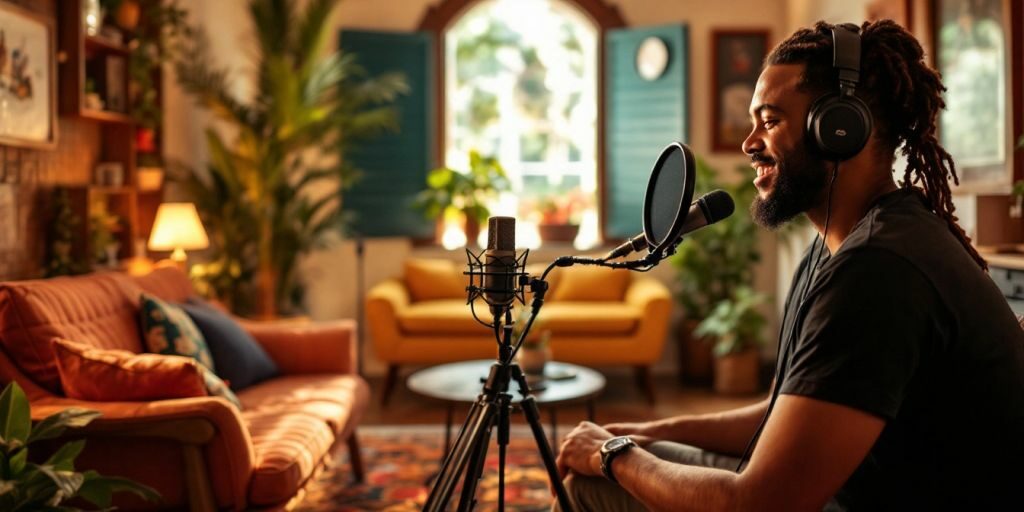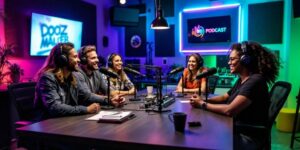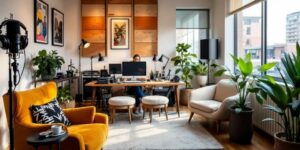In an increasingly visual digital landscape, video podcasts have emerged as a compelling way to capture and engage audiences. They combine the immersive storytelling power of podcasts with the visual dynamism of video content, making them ideal for brands, entrepreneurs, educators, and creatives alike. Whether you’re launching your first show or refining an existing one, this comprehensive guide will walk you through the essentials of video podcast production. From podcast video techniques to lighting, equipment, and editing tips, we’ll show you how to enhance your video podcast quality and achieve a professional podcast setup that commands attention.
Understanding the Value of Video Podcasting
The popularity of video podcasts has surged in recent years. Platforms like YouTube, Spotify, and Apple Podcasts now prioritize visual content, offering creators expanded opportunities to reach new audiences. A well-produced video podcast can boost your brand credibility, improve audience retention, and drive greater engagement compared to audio-only formats.
Viewers are more likely to connect with content that allows them to see the host’s facial expressions, body language, and surroundings. This visual connection builds trust and reinforces your message, which is why improving podcast visuals is a crucial step in standing out in a crowded market.
Planning a Professional Podcast Studio Setup
Before you hit the record button, it’s essential to plan a reliable and visually appealing studio setup. Creating a dedicated recording environment not only improves the final product but also saves you time during editing and post-production.
Start by selecting a quiet space with minimal background noise and natural light. Consider soundproofing materials or acoustic panels to control echo and enhance audio clarity. Use neutral or branded backdrops that reflect your podcast’s theme. Your podcast studio setup should be designed to minimize distractions and focus viewer attention on the hosts and guests.
Investing in ergonomic furniture and adjustable lighting also contributes to a comfortable and productive recording experience, making it easier to maintain energy and professionalism throughout each episode.
Choosing the Right Video Podcast Equipment
High-quality video production begins with the right equipment. At the core of your setup should be a reliable camera capable of capturing HD or 4K footage. Mirrorless and DSLR cameras are popular choices, but some webcams and smartphones can also produce professional results with proper lighting and positioning.
Complement your camera with a tripod or stabilizer to maintain steady shots. For audio, a condenser or dynamic microphone with a pop filter ensures crisp sound quality. Use audio interfaces or mixers to manage multiple inputs, especially if you have co-hosts or guests.
Lighting is often underestimated but plays a crucial role in creating high-quality podcast video. Ring lights, softboxes, or LED panels can evenly illuminate your subjects and eliminate shadows, significantly enhancing the visual experience.
Don’t overlook accessories like cables, memory cards, backup drives, and headphones. These components support smooth production and help troubleshoot technical issues during filming.
Mastering Podcast Lighting Techniques
Lighting is more than just turning on a lamp—it’s about shaping the look and feel of your show. Understanding podcast lighting techniques will help you create depth, eliminate harsh shadows, and draw viewers’ focus where you want it.
Three-point lighting is a standard technique used in professional setups. It consists of a key light (your primary source), a fill light (which softens shadows), and a backlight (to separate the subject from the background). Position your key light at a 45-degree angle to your face, slightly above eye level. Use the fill light on the opposite side to balance the shadows and prevent a dramatic contrast.
If you’re using natural light, try to film during the day when sunlight is abundant and diffuse it with sheer curtains to soften the effect. Avoid mixing light sources with different color temperatures, as this can result in unnatural skin tones and inconsistent visuals.
Exploring Podcast Camera Angles and Framing
Camera placement and framing can make a big difference in how your video podcast is perceived. Poor camera angles can be distracting or even unflattering, while thoughtful composition helps maintain a professional appearance.
Position the camera at eye level to create a direct connection with the viewer. This mimics a face-to-face conversation and fosters engagement. Avoid low angles that look up the nose or high angles that feel distant and impersonal.
Use the rule of thirds to frame your shots. Imagine your screen divided into nine equal sections by two vertical and two horizontal lines. Place the host’s eyes near the top third line for a balanced and visually appealing composition. Always check your background for clutter and distractions—what’s behind you says a lot about your brand.
Switching between multiple camera angles can also enhance the viewer experience. Consider wide shots to establish the setting and close-ups to highlight reactions or emphasize key points.
Essential Podcast Video Techniques for a Polished Production
Producing a video podcast involves more than just recording footage. Applying intentional podcast video techniques can elevate the final product and keep your audience coming back for more.
Use visual transitions between segments to signal a change in topic or tone. Include lower-third graphics to introduce guests or highlight important points. Animated logos, branded intros, and outros create a consistent identity across episodes.
On-screen text, charts, or screen shares can be integrated to illustrate complex ideas or provide visual support for discussions. Be cautious not to overuse these elements, as too much visual clutter can be overwhelming.
Adding background music subtly under certain segments can improve flow and create a polished feel. Just make sure to use royalty-free tracks or obtain proper licensing to avoid copyright issues.
Video Podcast Editing Tips for Maximum Impact
Post-production is where your raw footage is transformed into a polished final product. Effective video podcast editing can eliminate awkward pauses, improve pacing, and ensure consistent audio and visual quality.
Start by syncing your audio and video tracks. Use noise reduction tools to clean up background hums or hisses. Trim out filler words, tangents, or dead air to keep the content tight and engaging.
Color correction and grading are essential steps for enhancing your video’s look. Adjust brightness, contrast, and color balance to maintain a consistent appearance across shots. Use zoom-ins or camera cuts during editing to add variety and keep visual interest.
If you’re using multiple camera angles, editing software like Adobe Premiere Pro or Final Cut Pro allows for multi-cam editing, making it easy to switch between views.
Consider using captions or subtitles for accessibility and to cater to viewers watching without sound. Many platforms now prioritize video content with captions, as it increases reach and engagement.
Best Video Podcast Practices for Long-Term Success
Consistency and professionalism are the cornerstones of a successful video podcast. Establishing a repeatable process for production, from recording to publishing, will save time and ensure quality over the long term.
Develop a content calendar to plan topics, guests, and episode formats in advance. Keep your branding consistent by using the same intro, outro, music, and visual style. Promote each episode across multiple platforms, including YouTube, Spotify, and social media channels.
Collect viewer feedback and analytics to refine your content. Identify which topics, segments, or visual styles resonate most with your audience and adapt accordingly.
Engage with your viewers through comments, Q&A sessions, or live episodes. Building a community around your show increases loyalty and encourages organic growth.
How to Improve Podcast Visuals on a Budget
You don’t need to spend thousands of dollars to create a professional-looking video podcast. Many creators have achieved outstanding results using affordable gear and DIY solutions.
Use natural lighting whenever possible and enhance it with inexpensive LED lights. Backgrounds can be spruced up with plants, wall art, or fabric backdrops. Free editing software like DaVinci Resolve or iMovie provides powerful tools for beginners.
Borrow or rent equipment before making a significant investment. Many creators start with smartphones and gradually upgrade their gear as their show grows. The key is to focus on content quality and consistency—great visuals will follow with time and practice.
Conclusion: Elevate Your Content with Expert Video Podcast Production
Mastering video podcast production takes time, creativity, and attention to detail. From setting up your studio and selecting the right equipment to mastering lighting, camera angles, and editing techniques, every decision plays a role in shaping your final product. Applying the best video podcast practices not only enhances the viewing experience but also builds your credibility and brand authority.
Whether you’re just starting or ready to take your podcast to the next level, remember that quality visuals and thoughtful production make all the difference in a competitive market. And when you’re ready for professional support that delivers world-class results, look no further than Podcast Studio AZ.
At Podcast Studio AZ, we offer a full-service podcasting experience tailored to creators like you. From recording and editing to studio setup and consultation, our team helps you create high-quality podcast video content that stands out. Book your session today and bring your vision to life with the experts at Podcast Studio AZ.




